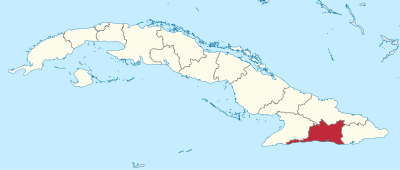| Statistics | |
|---|---|
| Capital: | Santiago de Cuba |
| Area: | 6,315km² |
| Inhabitants: | 1,049,084 |
| Population Density: | 168.32 per km² |
| Map | |
Santiago de Cuba Province is the second most populated province in the island of Cuba. It has a population of about 1.2 million people. The largest city Santiago de Cuba (554,000) is its main administrative center. Other large cities include Palma Soriano (125,000), Contramaestre (88,000), Mayarí Arriba (80,000), San Luis (65,000) and Songo-la Maya (50,000).

The province has many material resources such as iron and nickel. The economy, however, relies mostly on agriculture, with large plantations growing bananas, cacao and coffee dotting the landscape. Industry is growing around the capital, as is tourism. The natural beauty of the area is attracting many tourists from both the rest of Cuba and from overseas.
Santiago de Cuba province has been the site of many battles, both during the war for independence and the 1959 Cuban Revolution, where much of the guerrilla fighting took place in the mountainous province.
Municipalities
changeHistorical use of the name
changeBefore 1976, Cuba was divided into six provinces. One of these was Oriente province, which was, prior to 1905, known as Santiago de Cuba province. See Historical provinces of Cuba.
